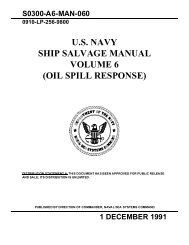Gallon JP-5 Spill at Naval Station Roosevelt Roads - Supervisor of ...
Gallon JP-5 Spill at Naval Station Roosevelt Roads - Supervisor of ...
Gallon JP-5 Spill at Naval Station Roosevelt Roads - Supervisor of ...
You also want an ePaper? Increase the reach of your titles
YUMPU automatically turns print PDFs into web optimized ePapers that Google loves.
Winter 1999/20006Training in Alaska 1999During the summer <strong>of</strong> 1999, SUPSALVEmergency Ship Salvage M<strong>at</strong>erial (ESSM)Base Anchorage continued to be involvedwith numerous exercises and training inconjunction with other organiz<strong>at</strong>ions.These exercises were conducted to meetthe N<strong>at</strong>ional Preparedness for ResponseExercise Program (NPREP) and to improvethe capabilities to work in a unified responsescenario.During the period <strong>of</strong> 25–29 April 1999,ESSM Base Anchorage mobilized a boomvan, workshop van, bo<strong>at</strong>s, and a ClassXI skimmer system to Homer, Alaska. Onethousand feet <strong>of</strong> FUG boom was deployedto support a USCG VOSS system.The boom was exercised in a U-boomconfigur<strong>at</strong>ion collecting and dumping forward<strong>of</strong> the skimming system. Next, theClass XI skimming system was deployedfrom the USCGC Sedge in conjunctionwith two fishing vessels towing oceanboom in an open apex U-boom configur<strong>at</strong>ionforward <strong>of</strong> the skimming system.Other organiz<strong>at</strong>ions involved with theexercise included the Alaska Department<strong>of</strong> Environmental Conserv<strong>at</strong>ion, the U.S.Coast Guard, CISPRI, Chadux, and theSeldovia Oil <strong>Spill</strong> Response Team. Theprimary objective <strong>of</strong> the overall exercisewas equipment deployment in a unifiedresponse.On 19 July 1999, SUPSALV received acall from Eielson Air Force Base requestingoil spill response assistance. Thiscall initi<strong>at</strong>ed the beginning <strong>of</strong> an equipmentdeployment exercise to test responsetimes from ESSM Base Anchorage toEielson AFB, loc<strong>at</strong>ed near Fairbanks,Alaska.Without prior arrangements, ESSMBase Anchorage was able to prepare theequipment and make prepar<strong>at</strong>ions fortrucking the equipment to Eielson AFBwith a total response time on site <strong>of</strong> 10hours. Air transport<strong>at</strong>ion from ElmendorfAFB and Kulis Air N<strong>at</strong>ional Guard Basewas also investig<strong>at</strong>ed. C-130 aircraftcould be available from both sites withintwo hours, resulting in a total responsetime to Eielson AFB <strong>of</strong> six hours.The actual equipment exercise was on23–24 July 1999. The exercise involvedboth a tabletop exercise and an equipmentdeployment. An inland skimmingsystem van, inland boom van, and acleaning van were mobilized to EielsonAFB. The first day involved equipmentassembly and training. This was the firsttime for ESSM Base Anchorage personnelto set up the cleaning van system inan exercise. On July 24 equipment wasdeployed in response to a scenario involvingpipeline breaks resulting in oilflowing down both French Creek andMoose Creek. Eielson AFB resourceswere utilized in the French Creek areawith SUPSALV equipment being deployedon Moose Creek. ESSM BaseAnchorage personnel set up two containmentand recovery sites along MooseCreek utilizing skimmers from the inlandskimming system van. Sunflower seedswere dumped in the creeks to simul<strong>at</strong>e oiland were completely contained <strong>at</strong> the firstcontainment area. Other organiz<strong>at</strong>ions involvedin this exercise included the EnvironmentalProtection Agency, the AlaskaDepartment <strong>of</strong> Environmental Conserv<strong>at</strong>ion,and the North Star Borough Fire Department.SUPSALV received high praisefrom all the participants.On 24–26 August 1999, ESSM BaseAnchorage particip<strong>at</strong>ed in CAN/USNorth, an equipment deployment exercisein support <strong>of</strong> the U.S. Coast Guardand Canadian Coast Guard. The exercisewas designed to test the issues involvedin deploying equipment from the UnitedSt<strong>at</strong>es to Canada to assist in an oil spillresponse. SUPSALV equipment wastransported by USCG C-130 aircraft fromAnchorage, Alaska, to Tuktoyaktuk,Northwest Territories, Canada. Equipmenttransported included a heavy oiltransfer system and several small skimmersfrom the inland skimming system.The Canadian Coast Guard deployed twodifferent booming systems and severalskimmers from their base inTuktoyaktuk. The scenario addressed thecollision <strong>of</strong> two tank barges with oil inthe w<strong>at</strong>er and one barge requiringlightering.In addition to the equipment deployment,other areas tested included communic<strong>at</strong>ions,customs concerns, transport<strong>at</strong>ion,and the procedures for the CanadianCoast Guard to request SUPSALVassistance.ESSM Base Anchorage continues toparticip<strong>at</strong>e in numerous oil spill responseexercises. These exercises ensure th<strong>at</strong>they are always prepared to support DODfacilities and Federal On-Scene Coordin<strong>at</strong>orswhen called upon.
















